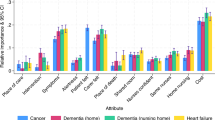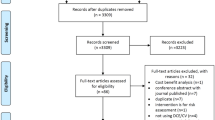Abstract
Introduction
Designing and funding chemotherapy care to meet patient expectations is challenging. Issues including convenience, outcomes, cost, and continuity of care are all potentially important and the appropriate trade-off between them is not clear. Regions with significant geographic spread and concentration of care in metropolitan areas pose a particular problem as ensuring low-cost convenient care is potentially difficult. However, the relative value of different aspects of chemotherapy are as yet unknown. The objective of this work is to quantify the relative value of different aspects of chemotherapy service delivery in an older Australian general population sample.
Methods
A discrete choice experiment was administered in an older Australian general population sample without cancer. The survey approach asks a series of hypothetical choice tasks and allows estimation of the relative value of different aspects of care. Analysis considered the average respondent, and then also explored the level of preference divergence across the population.
Results
One thousand and sixty-two individuals provided data and were included in the analysis. There was a strong population preference for home-based chemotherapy, for follow-up by a specialist, for psycho-social support, and for low cost care.
Conclusion
These strong population preferences should be considered when designing chemotherapy care. This poses a significant challenge, both logistically and financially. However, this information can help policy makers identify the components of good value care.

Similar content being viewed by others
Data Availability Statement
The datasets generated during and/or analysed during the current study are not publicly available due to constraints imposed in the Ethics process but are available from the corresponding author on reasonable request subject to approval from an appropriate HREC.
References
King MT, Viney R, Pickard AS, Rowen D, Aaronson NK, Brazier JE, et al. Australian Utility weights for the EORTC QLU-C10D, a multi-attribute utility instrument derived from the cancer-specific quality of life questionnaire, EORTC QLQ-C30. Pharmacoeconomics. 2018;36:225–38. https://doi.org/10.1007/s40273-017-0582-5.
Beusterien K, Grinspan J, Kuchuk I, Mazzarello S, Dent S, Gertler S, et al. Use of conjoint analysis to assess breast cancer patient preferences for chemotherapy side effects. Oncologist. 2014;19(2):127–34. https://doi.org/10.1634/theoncologist.2013-0359.
Bien DR, Danner M, Vennedey V, Civello D, Evers SM, Hiligsmann M. Patients’ preferences for outcome, process and cost attributes in cancer treatment: a systematic review of discrete choice experiments. Patient. 2017;10(5):553–65. https://doi.org/10.1007/s40271-017-0235-y.
Department of Health and Ageing. Funding for new medical technologies and procedures: application and assessment guidelines. Canberra: Department of Health and Ageing; 2005.
National Institute for Health and Care Excellence. Guide to the methods of technology appraisal. London: NICE2013.
Lakdawalla DN, Doshi JA, Garrison LP Jr, Phelps CE, Basu A, Danzon PM. Defining elements of value in health care-a health economics approach: an ISPOR special task force report [3]. Value Health. 2018;21(2):131–9. https://doi.org/10.1016/j.jval.2017.12.007.
Bessen T, Chen G, Street J, Eliott J, Karnon J, Keefe D, et al. What sort of follow-up services would Australian breast cancer survivors prefer if we could no longer offer long-term specialist-based care? A discrete choice experiment. Br J Cancer. 2014;110(4):859–67. https://doi.org/10.1038/bjc.2013.800.
Goodall S, King M, Ewing J, Smith N, Kenny P. Preferences for support services among adolescents and young adults with cancer or a blood disorder: a discrete choice experiment. Health Policy. 2012;107(2–3):304–11. https://doi.org/10.1016/j.healthpol.2012.07.004.
Jong KE, Smith DP, Yu XQ, O’Connell DL, Goldstein D, Armstrong BK. Remoteness of residence and survival from cancer in New South Wales. Med J Aust. 2004;180(12):618–22.
Blinman P, King M, Norman R, Viney R, Stockler MR. Preferences for cancer treatments: an overview of methods and applications in oncology. Ann Oncol. 2012;23(5):1104–10. https://doi.org/10.1093/annonc/mdr559.
Choice Metrics Pty Ltd. Ngene User Manual and Reference Guide (version 1.2). 2018.
de Bekker-Grob EW, Donkers B, Jonker MF, Stolk EA. Sample size requirements for discrete-choice experiments in healthcare: a practical guide. Patient. 2015;8(5):373–84. https://doi.org/10.1007/s40271-015-0118-z.
Lancsar E, Louviere J. Conducting discrete choice experiments to inform healthcare decision making: a user’s guide. Pharmacoeconomics. 2008;26(8):661–77.
Hole AR. A comparison of approaches to estimating confidence intervals for willingness to pay measures. Health Econ. 2007;16:827–40.
Mulhern B, Longworth L, Brazier J, Rowen D, Bansback N, Devlin N, et al. Binary choice health state valuation and mode of administration: head-to-head comparison of online and CAPI. Value Health. 2013;16(1):104–13. https://doi.org/10.1016/j.jval.2012.09.001.
Acknowledgements
We acknowledge funding for the study fieldwork from the Cancer Council of Western Australia. We also acknowledge the vital input of our Consumer Reference Group in this work.
Author information
Authors and Affiliations
Contributions
RN initiated the project, co-developed the protocol, led on data collection and analysis, and drafted the manuscript. MA, AH, IL and SR co-developed the protocol, assisted with interpretation of findings, and provided comments and other input on the manuscript.
Corresponding author
Ethics declarations
Conflict of interest
None.
Electronic supplementary material
Below is the link to the electronic supplementary material.
Rights and permissions
About this article
Cite this article
Norman, R., Anstey, M., Hasani, A. et al. What Matters to Potential Patients in Chemotherapy Service Delivery? A Discrete Choice Experiment. Appl Health Econ Health Policy 18, 589–596 (2020). https://doi.org/10.1007/s40258-020-00555-y
Published:
Issue Date:
DOI: https://doi.org/10.1007/s40258-020-00555-y




